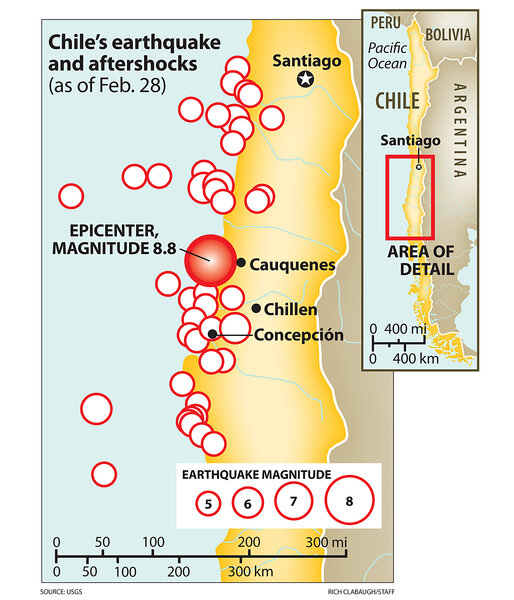Chile earthquake: How California would fare
Loading...
| Los Angeles
California is well prepared to deal with an earthquake on par with the Chile earthquake on Saturday, but residents can do more to help themselves, disaster preparedness experts say.
Because it lies on the San Andreas fault, the tectonic boundary between the Pacific and the North American plates, California’s vulnerability to earthquakes has been well-documented since the late 1800s. Because building codes call for steel reinforcements – some tall buildings are even built on rolling foundations – the physical devastation to man-made structures that would happen here in a massive earthquake would be far less than Haiti or Chile.
Government response in California is also among the most sophisticated in the US, according to David Paulison, a head administrator for FEMA from 2005 to 2009.
IN PICTURES: Images from the 8.8 magnitude earthquake in Chile
“Alongside Texas and Florida, California really has outstanding institutional preparedness for a major disaster,” says Mr. Paulison. “It has proven over and over during its wildfires that it also has probably the greatest mutual aid system in the country, the ability to share and coordinate equipment and personnel with neighboring states, counties and locales. I am completely comfortable that the state emergency network is in place to best deal with a catastrophic disaster of epic proportions. They’ve asked all the right questions, designed and funded the appropriate programs.”
What Paulison and other veteran observers are not comfortable with, however, is the question of personal responsibility: the issue of whether residents have taken the time to sufficiently map out where they would go, how they would get there – and that they have enough food and water to live comfortably without public assistance for three to four days.
“We’ve seen this over and over – from Katrina to the hurricanes in Florida – that despite the long lead-time warnings of these disasters, people did not plan correctly and thus millions became homeless,” says Paulison.
Paulison is just back from Haiti, where 2.5 million are homeless. “They have nowhere to go and the devastation and living conditions are unbelievable,” he says. Likewise, in Chile, a reported 200,000 are homeless. A million were homeless after Katrina, he says.
“These present incredible problems because people have to go out on the streets. Things would be so much different and easier for relief efforts if these people had planned to have flashlights and radios and batteries – as well as drinking water and food for up to four days. There is no reason individuals can’t be ready for this.”
Dr. Maurice Ramirez, founder and CEO of consulting firm High Alert International says California is as ready as any modern region can be for a major earthquake, which he defines as a 7.0 or above on the Richter scale, but education lags behind.
First lady Maria Shriver Schwarzenegger has been an active proponent of community and individual preparedness in California since her husband took office in 2003, Mr. Ramirez notes. “While this has certainly helped raise the level of awareness, individual preparedness and self education [are] still an individual matter,” he says. “Californians are only slightly better prepared than the average American for disaster. The same is true of Floridians and hurricanes.”
Like other states with a high risk of large numbers of persons displaced by disaster, California has shelters and medical stations designated at the local, county, state, regional, and federal levels. These are in addition to facilities provided by non-governmental organizations (NGOs) such as the Red Cross, and Faith Based Organizations (FBOs) such as ACTS World Relief.
In the wake of Haiti and Chile earthquakes, California should incorporate basic disaster preparedness in school curriculum starting in kindergargen, Ramirez says.
“The National Fire Safety Initiative has saved countless lives in household fires, not to mention workplace fires, and all evidence indicates that similar success would be seen with the same program instituted for disaster preparedness at the kindergarten level.”
Another issue on which residents seem ill-informed is earthquake insurance, according to Pete Moraga, a spokesperson for the Insurance Information Network of California, a non-profit, non-lobbying media relations organization. He says the massive earthquake drills that took place in 2008 and 2009 – participated in by millions of school children – raised public consciousness of how to protect yourself during an earthquake. But polls by his organization show residents are woefully underinsured – and many don’t know it.
“Since the Northridge Earthquake here in 1994, the percentage of people with earthquake insurance has dropped from 30 percent to 12.5 percent,” says Moraga. And a 2006 audit and poll of insurance showed that 31 percent of Californians thought they had earthquake insurance, when the actual amount was only 13 percent.
Ramirez says the very definition of “earthquake prepared” needs to be examined.
“It is possible to be disaster prepared, meaning ready to respond and recover to a disaster generically, but the concept of being 'EQ prepared' implies that the earthquake will have less effect on you than your neighbor who is not 'EQ prepared.' This is simply not true at any level of quake. Prepare to respond, prepared to survive, prepare to recover, and prepare to move on," he says. "That is disaster preparedness.”
IN PICTURES: Images from the 8.8 magnitude earthquake in Chile






